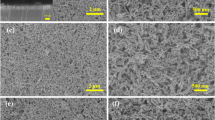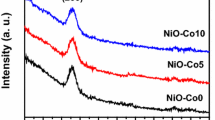Abstract
Nickel oxide, as an anode electrochromic material, has the advantages of a large color modulation range, good cycle life and strong ion storage capacity, and low raw material price, so it is considered to have the potential for large-scale commercial application. In this paper, the electrochromic properties of the ZnO-doped NiO film prepared via magnetron sputtering technology were studied. Moreover, the content of ZnO in NiO films can be controlled by the adjustable ZnO target’s sputtering power. The doping of ZnO augmented the film crystallinity and the contact area between the film and the electrolyte, thereby improving electrochromic properties. Compared with pure NiO film, the NiO film doped with ZnO at a power of 40 W (the abbreviation is ZnO-40) markedly promotes the migration of Li+, the film’s cycle stability, and electrochromic properties. At the 20th cycle, the optical contrast of the ZnO-40 film was 45.27%, the coloration efficiency was 32.53 cm2/C, the coloration time was 3.1 s, and the bleaching time was 1.1 s. At the 100th cycle, the optical contrast was 43.66%, the coloration efficiency was 28.79 cm2/C, and the reversibility was 99.59%. After 1000 cycles, the optical contrast could steadily reach 42.83%, the coloration efficiency was 60.38cm2/C, and the reversibility was 98.12%.












Similar content being viewed by others
Data availability
Data will be made available on request.
References
A. Huang, L. Lei, J. Zhu, Y. Yu, Achieving High Current Density of Perovskite Solar cells by modulating the dominated facets of room-temperature DC Magnetron sputtered TiO2 Electron extraction layer. ACS Appl. Mater. Interfaces. 9, 2016–2022 (2017). https://doi.org/10.1021/acsami.6b14040
F. Lin, D. Nordlund, T.C. Weng, R.G. Moore, Hole doping in Al-containing nickel oxide materials to improve electrochromic performance. ACS Appl. Mater. Interfaces. 05, 301–309 (2013). https://doi.org/10.1021/am302097b
D.R. Rosseinsky, R.J. Morter, Electrochromic systems and the prospects for devices. Adv. Mater. 13, 783–793 (2001). https://doi.org/10.1002/1521-4095(200106)13:11<783::AID-ADMA783>3.0.CO;2-D
X.L. Zhong, X.Q. Liu, X.G. Diao, Electrochromic devices based on Tungsten Oxide and Nickel Oxide: a review. J. Inorg. Mater. 36, 128–139 (2021). https://doi.org/10.15541/jim20200488
S. Hou, A.I. Gavrilyuk, J. Zhao, H. Geng, Controllable crystallinity of nickel oxide film with enhanced electrochromic properties. Appl. Surf. Sci. 451, 104–111 (2018). https://doi.org/10.1016/j.apsusc.2018.04.206
D. Dong, W. Wang, A. Barnabé, L. Presmanes, Enhanced electrochromism in short wavelengths for NiO:(Li, mg) films in full inorganic device ITO/NiO:(Li, mg)/Ta2O5/WO3/ITO. Electrochim. Acta. 263, 277–285 (2018). https://doi.org/10.1016/j.electacta.2018.01.049
R. Wang, H. Lin, H.B. Zhu, M.X. Wan, Preparation, investigation and application of nickel oxide thin films in flexible all-thin-film electrochromic devices: from material to device. J. Alloy Compd. 898, 162879 (2022). https://doi.org/10.1016/j.jallcom.2021.162879
Y.C. He, T.Z. Li, X.L. Zhong, M.A. Zhou, Lattice and electronic structure variations in critical lithium doped nickel oxide thin film for superior anode electrochromism. Electrochim. Acta. 316, 143–151 (2019). https://doi.org/10.1016/j.electacta.2019.05.112
X. Zhang, W.J. Li, L.B. Wang, X. Chen, Reflective property of Inorganic Electrochromic materials. J. Inorg. Mater. 36, 451–460 (2021). https://doi.org/10.15541/jim20200465
M. Fakharpour, M.H.K. Tafti, Temperature and substrate effect on the electrical and structural properties of NiO columnar nanostructure. Appl. Phys. A-Mater. 129, 234 (2023). https://doi.org/10.1007/s00339-023-06454-y
V. Bayzi Isfahani, M.M. Silva, Fundamentals and advances of Electrochromic systems: a review. Adv. Eng. Mater. 23, 2100567 (2021). https://doi.org/10.1002/adem.202100567
D. Dong, W. Wang, G. Dong, F. Zhang, Electrochromic properties and performance of NiOx films and their corresponding all-thin-film flexible devices preparedby reactive DC magnetron sputtering. Appl. Surf. Sci. 383, 49–56 (2016). https://doi.org/10.1016/j.apsusc.2016.04.154
D. Zhou, D. Xie, X. Xia, X. Wang, All-solid-state electrochromic devices based on WO3||NiO films: material developments and future applications. Sci. China Chem. 60, 3–12 (2016). https://doi.org/10.1007/s11426-016-0279-3
S.H. Lee, S.J. Lee, R. Kim, H.-W. Kang, Durability-enhanced monolithic inorganic electrochromic devices with tantalum-doped nickel oxide as a counter electrode. Sol Energ. Mat. Sol C 234, 111435 (2022). https://doi.org/10.1016/j.solmat.2021.111435
M.Y. Pan, Q. He, J.-. Liu, K. Du, A double network hydrogel electrolyte-based electrochromic device for enhanced electrochromic performance and lower power consumption. Dyes Pigm. 212, 111126 (2023). https://doi.org/10.1016/j.dyepig.2023.111126
Y. Zhao, X. Zhang, X. Chen, W. Li, Preparation of Sn-NiO films and all-solid-state devices with enhanced electrochromic properties by magnetron sputtering method. Electrochim. Acta. 367, 137457 (2021). https://doi.org/10.1016/j.electacta.2020.137457
K. Zhou, Z. Qi, B. Zhao, S. Lu, The influence of crystallinity on the electrochromic properties and durability of NiO thin films. Surf. Interfaces. 6, 91–97 (2017). https://doi.org/10.1016/j.surfin.2016.12.004
F. Şenaslan, M. Taşdemir, A. Çelik, Effect of working pressure and post-annealing on structural, optical and electrical properties of p-type NiO thin films produced by RF magnetron sputtering technique. Appl. Phys. A-Mater. 127, 739 (2021). https://doi.org/10.1007/s00339-021-04901-2
M.A. Green, The Passivated Emitter and Rear Cell (PERC): from conception to mass production. Sol Energ. Mat. Sol C 143, 190–197 (2015). https://doi.org/10.1016/j.solmat.2015.06.055
M.S. Abdel-wahab, H.K. El Emam, W.M.A. El, Rouby, Sputtered Ag-doped NiO thin films: structural, optical, and electrocatalytic activity toward methanol oxidation. J. Mater. Sci-Mater El. 34, 1637 (2023). https://doi.org/10.1007/s10854-023-11029-x
J.Y. Chang, Y.C. Chen, C.M. Wang, Y.W. Chen, Electrochromic properties of Li- Doped NiO films prepared by RF Magnetron Sputtering. Coatings. 10, 87 (2020). https://doi.org/10.3390/coatings10010087
Q. Huang, Q. Zhang, Y. Xiao, Y. He, Improved electrochromic performance of NiO-based thin films by lithium and tantalum co-doping. J. Alloy Compd. 747, 416–422 (2018). https://doi.org/10.1016/j.jallcom.2018.02.232
J. Varghese, N.R. Aswathy, S.D. Saji, R. Vinodkumar, Structural and optical modification of ZnO:Al thin films by molybdenum co-doping and the origin of green emission. 2nd International Conference on Condensed Matter and Applied Physics (Icc 2017) 1953, 030079 (2018). https://doi.org/10.1063/1.5032414
T. Maruyama, S. Arai, The electrochromic properties of nickel oxide thin films prepared by chemical vapor deposition. Sol Energ. Mat. Sol. Cells 30, 257–262 (1993). https://doi.org/10.1016/0927-0248(93)90145-S
Y.E. Firat, Influence of current density on Al: NiO thin films via electrochemical deposition: Semiconducting and electrochromic properties. Mat. Sci. Semicond. Proc. 109, 104958 (2020). https://doi.org/10.1016/j.mssp.2020.104958
K. Sathishkumar, N. Shanmugam, N. Kannadasan, S. Cholan, Influence of Zn2+ ions incorporation on the magnetic and pseudo capacitance behaviors of NiO nanoparticles. Mat. Sci. Semicond. Proc. 27, 846–853 (2014). https://doi.org/10.1016/j.mssp.2014.08.025
S.H. Park, J.W. Lim, S.J. Yoo, I.Y. Cha, The improving electrochromic performance of nickel oxide film using aqueous N, N-dimethylaminoethanol solution. Sol Energ. Mat. Sol C 99, 31–37 (2012). https://doi.org/10.1016/j.solmat.2011.06.023
B. Hao, J. Guo, L. Zhang, H. Ma, Magnetron sputtered TiO2/CuO heterojunction thin films for efficient photocatalysis of rhodamine B. J. Alloy Compd. 903, 163851 (2022). https://doi.org/10.1016/j.jallcom.2022.163851
C. Wu, Y. Yang, W.W. Feng, W.J. Song, Towards superior nickel oxide electrochromic films using Si and Li co-doping and rapid thermal annealing. J. Alloy Compd. 862, 158665 (2021). https://doi.org/10.1016/j.jallcom.2021.158665
F. Wang, J. Jia, W. Zhao, L. Zhang, Preparation and electrochromic properties of NiO and ZnO-doped NiO thin films. Mat. Sci. Semicond. Proc. 151, 106986 (2022). https://doi.org/10.1016/j.mssp.2022.106986
F. Abrinaei, M.T. Hosseinnejad, M. Shirazi, F. Shahgoli, Characterisation of nanostructured SnO2 thin films synthesised by magnetron sputtering and application in a carbon monoxide gas sensor. J. Chem. Res. 40, 436–441 (2016). https://doi.org/10.3184/174751916x14656576466887
X. Yang, J. Guo, Y. Zhang, W. Liu, Hole-selective NiO: Cu contact for NiO/Si heterojunction solar cells. J. Alloy Compd. 747, 563–570 (2018). https://doi.org/10.1016/j.jallcom.2018.03.067
Q. Liu, G. Dong, Y. Xiao, M.-P. Delplancke-Ogletree, Electrolytes-relevant cyclic durability of nickel oxide thin films as an ion-storage layer in an all-solid-state complementary electrochromic device. Sol Energ. Mat. Sol C 157, 844–852 (2016). https://doi.org/10.1016/j.solmat.2016.07.022
I. Valyukh, S. Green, H. Arwin, G.A. Niklasson, Spectroscopic ellipsometry characterization of electrochromic tungsten oxide and nickel oxide thin films made by sputter deposition. Sol Energ. Mat. Sol C 94, 724–732 (2010). https://doi.org/10.1016/j.solmat.2009.12.011
K.S. Usha, R. Sivakumar, C. Sanjeeviraja, V. Sathe, Improved electrochromic performance of a radio frequency magnetron sputtered NiO thin film with high optical switching speed. Rsc Adv. 6, 79668–79680 (2016). https://doi.org/10.1039/c5ra27099e
Y. Xiao, G. Dong, J. Guo, Q. Liu, Thickness dependent surface roughness of sputtered Li2.5TaOx ion conductor and its effect on electro-optical performance of inorganic monolithic electrochromic device. Sol Energ. Mat. Sol C 179, 319–327 (2018). https://doi.org/10.1016/j.solmat.2017.12.027
T. Potlog, L. Ghimpu, V. Suman, A. Pantazi, Influence of RF sputtering power and thickness on structural and optical properties of NiO thin films. Mater. Res. Express. 6, 096440 (2019). https://doi.org/10.1088/2053-1591/ab317d
V. Bayzi Isfahani, A. Arab, J. Horta Belo, J. Pedro Araujo, Comparison of Physical/Chemical properties of prussian Blue Thin films prepared by different pulse and DC Electrodeposition methods. Materials. 15, 8857 (2022). https://doi.org/10.3390/ma15248857
V.B. Isfahani, N. Memarian, H.R. Dizaji, A. Arab, The physical and electrochromic properties of prussian blue thin films electrodeposited on ITO electrodes. Electrochim. Acta. 304, 282–291 (2019). https://doi.org/10.1016/j.electacta.2019.02.120
Y.E. Firat, A. Peksoz, Efficiency enhancement of electrochromic performance in NiO thin film via Cu doping for energy-saving potential. Electrochim. Acta. 295, 645–654 (2018). https://doi.org/10.1016/j.electacta.2018.10.166
J. Qiu, Z. Chen, T. Zhao, Z. Chen, Electrochromic properties of NiOx films deposited by DC Magnetron Sputtering. J. Nanosci. Nanotechno. 18, 4222–4229 (2018). https://doi.org/10.1166/jnn.2018.15263
C.B. Amara, H. Hammami, S. Fakhfakh, A. Kallel, Investigation of effects of ZrO2 Doping on Electrical properties of Soda Lime Silicate glasses using Dielectric Spectroscopy. J. Electron. Mater. 50, 5915–5924 (2021). https://doi.org/10.1007/s11664-021-09129-7
Funding
The work was supported by National Natural Science Foundation of China (Grant No. 51904272).
Author information
Authors and Affiliations
Contributions
Fei Wang: Formal analysis, Methodology, Writing—original draft, Writing—review & editing. Weike Zhang: Investigation, Writing—review & editing. Jia Jia: Data curation, Formal analysis, Writing—original draft, Writing—review & editing. Yunlong Chen: Investigation. Zhixin Chen: Visualization. Zeshi Wang: Visualization. Lan Zhang: Writing—review & editing. Huizhong Ma: Writing—review & editing.
Corresponding author
Ethics declarations
Conflict of interest
The authors declare that they have no known competing financial interests or personal relationships that could have appeared to influence the work reported in this paper.
Additional information
Publisher’s Note
Springer Nature remains neutral with regard to jurisdictional claims in published maps and institutional affiliations.
Rights and permissions
Springer Nature or its licensor (e.g. a society or other partner) holds exclusive rights to this article under a publishing agreement with the author(s) or other rightsholder(s); author self-archiving of the accepted manuscript version of this article is solely governed by the terms of such publishing agreement and applicable law.
About this article
Cite this article
Wang, F., Zhang, W., Jia, J. et al. Improvement of electrochromic properties of NiO film doped with ZnO prepared by magnetron sputtering. J Mater Sci: Mater Electron 35, 455 (2024). https://doi.org/10.1007/s10854-024-12172-9
Received:
Accepted:
Published:
DOI: https://doi.org/10.1007/s10854-024-12172-9




